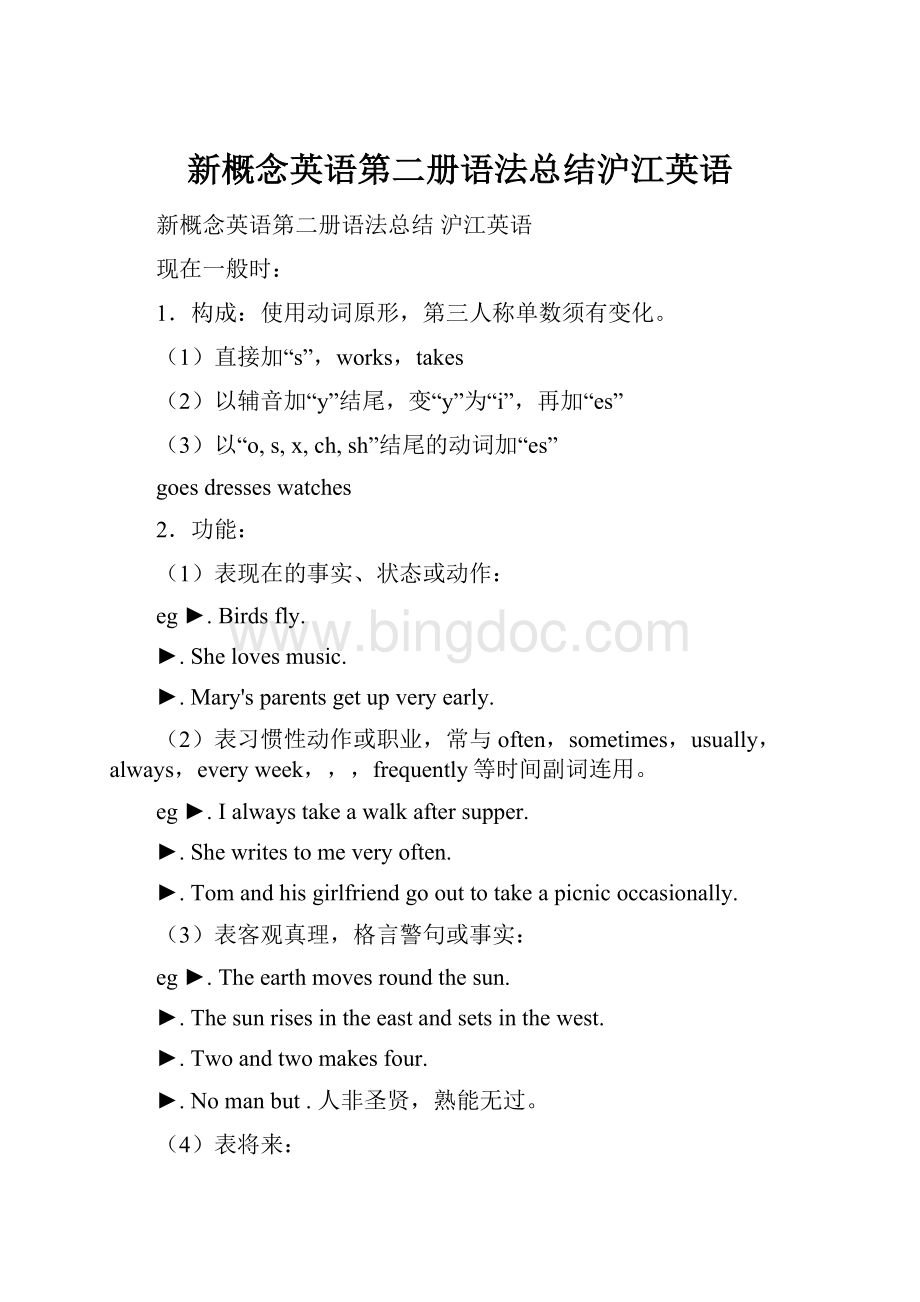新概念英语第二册语法总结沪江英语.docx
《新概念英语第二册语法总结沪江英语.docx》由会员分享,可在线阅读,更多相关《新概念英语第二册语法总结沪江英语.docx(12页珍藏版)》请在冰点文库上搜索。

新概念英语第二册语法总结沪江英语
新概念英语第二册语法总结沪江英语
现在一般时:
1.构成:
使用动词原形,第三人称单数须有变化。
(1)直接加“s”,works,takes
(2)以辅音加“y”结尾,变“y”为“i”,再加“es”
(3)以“o,s,x,ch,sh”结尾的动词加“es”
goesdresseswatches
2.功能:
(1)表现在的事实、状态或动作:
eg►.Birdsfly.
►.Shelovesmusic.
►.Mary'sparentsgetupveryearly.
(2)表习惯性动作或职业,常与often,sometimes,usually,always,everyweek,,,frequently等时间副词连用。
eg►.Ialwaystakeawalkaftersupper.
►.Shewritestomeveryoften.
►.Tomandhisgirlfriendgoouttotakeapicnicoccasionally.
(3)表客观真理,格言警句或事实:
eg►.Theearthmovesroundthesun.
►.Thesunrisesintheeastandsetsinthewest.
►.Twoandtwomakesfour.
►.Nomanbut.人非圣贤,熟能无过。
(4)表将来:
A.在由when,after,before,as,assoonas,although,ause,if,evenif,incase,till,until,unless,
solongas,where,whatever,wherever等引导的状语从句中用一般现在时表将来发生的动作。
(黄金重点,所有考试都不放过它!
)
eg►.I'lltellherwhenshecomestomorrow.
►.Evenifitrainsthisafternoon,I'llmeetyou.
►.Whateverhappens,youshouldkeepcool-headed.(不错的句型,背下!
!
)
►.I'llberightherewaitingforyouwhereveryougo.(很感人的句型!
)
B.按时间表示将要发生的动作或事件,用一般现在时表达将来时概念。
eg►.Theplaybeginsat6:
30thisevening.
►.Whendoestheplanetakeoff?
►.Heleavesforthatcitynextweek.
►.Accordingtothe,thetraintoShanghaistartsatnineinthemorning.
(按照时刻表,开往上海的特快列车早上7点出发。
)
现在进行时:
1.构成:
is/am/are+现在分词
2.功能:
(1)表示现在正在进行的动作。
►.Theisboiling.ShallImaketea?
►.Don'tyouthinkyoueattoomuch?
You'reputtingonweight.
►.Theworkersarebuildinganewbridgeacrosstheriver.
(2)表现阶段正进行的动作。
►.Heistakingphysicsthis.
►.Wearepreparingforourfinalexaminationthisweek.
(3)go,come,leave,arrive,land,meet,die,start,return,join,etc.用于进行时态时表示即将开始的动作。
►.Look!
Thebusiscoming.看!
车来了!
►.Theoldmanisill,andheisdying.
►.AliceisleavingforBeijingwithhermother.
(4)与always,forever,continually,constantly等副词连用,表示说话人带有感情色彩:
赞赏或厌恶。
►.Heisalwaysthinkingofothers.(他总是想着别人。
)
►.Theboyiscontinuallymakingnoises.(这男孩不断地发出吵闹声。
)
►.Theteacherisconstantly(always)herforbeinglate.(老师一直在批评她迟到。
)
(5)下面表示状态、感觉、情绪、精神活动的动词不可用于进行时。
(此条戒律请背10遍!
!
!
)
believe(相信),doubt(怀疑),see(看见),hear(听见),know(知道),understand(理解),belong(属于),think(认为),consider(认为),feel(觉得),look(看起来),seem(看上去),show(显示),mind(介意),have(有),sound(听起来),taste(尝起来),require(要求),possess(拥有),care(关心),like(喜欢),hate(讨厌),love(喜爱),detest(憎恨),desire(意欲)
【简单记忆】
●永远不要说I'mbelieving...或Heisseeingahouse.再简单一点说,这些动词后面不要随意加-ing.
●可怕的是:
我们在及中常犯此类大错!
●注意:
haveaparty/thinkabout可以用进行时,因为这里have意为“举行”;think意为“考虑”。
现在完成时:
1.构成:
have/has+过去分词
2.功能:
(1)表示过去所发生的动作对现在的影响或产生的结果。
常与yet,just,before,,lately(最近),ever,never等表时间的副词搭配使用。
►.Hehasn'tseenherlately.
►.Ihaven'tfinishedthebookyet.
(2)表示一个从过去某个时间开始,延续到现在并可能持续下去的动作,常与表示一段时间的时间状语连用。
如:
sofar(迄今为止),uptillnow(直到现在),since,foralongtime(很长时间),uptopresent(直到现在),inthepast/inthelastfewyears(在过去的几年里),thesedays(目前)……
►.Hehasworkedherefor15years.
►.IhavestudiedEnglishsinceIcamehere.
►.TheforeignerhasbeenawayfromChinaforalongtime.
►.Sofar,Ihaven'treceivedaletterfrommybrother.
(3)某些非延续性动词(即:
动作开始便终止的动词),在现在完成时中不能与表示一段时间状语搭配。
黄金要点:
I.常见的非延续动词:
die,arrive(到达),join(加入),leave(离开),go,refuse(拒绝),fail(失败),finish,buy,marry,divorce(离婚),awake(醒),buy,borrow,lend...(背三遍!
)
II.这类动词并非不能用现在完成时,而是不能接常由for引导的时间状语。
III.但若是用在否定句中,非延续动词的现在完成时可以与表示一段时间的状语连用。
►.Shehasgoneawayforamonth.(误)
►.Shehasbeenawayforamonth(正)
►.Themanhasdiedfortwoyears.(误)
►.Themanhasbeendeadfortwoyears.(正)
►.Howlonghaveyouboughtthebook?
(误)
►.Howlonghaveyougotthebook.(正)
(4)注意since的用法:
►.Theyhaven'thadanytroublesincetheycamehere.
►.Ithasbeentenyearssincewemetlasttime.
►.Hehasbeenheresince1980.
►.Hehasbeenheresincetenyearsago.
现在完成进行时:
1.构成:
have/has+been+现在分词
2.功能:
(1)表示从过去某时开始发生,一直延续到现在且可能延续下去的动作。
(最好将此定义读5遍)
►.I'vebeenwaitingforanhourbutshehasn'tcome.
►.Hehasbeenherfor8years.
(2)表某种感情色彩。
►.I'vebeenwantingtoseeyouforsomanyyears.
►.Who'sbeentellingyousuch.
现在完成时与现在完成进行时的对比:
现在完成时强调“结果”,而完成进行时强调“动作的延续”。
►.Ihavethoughtofit.(我已想到了这一点。
)
►.Ihavebeenthinkingofit.(我一直在想这一点。
)
►.Jimhaspaintedthedoor.(杰姆已将门油漆过了。
)
►.Jimhasbeenpaintingthedoor.(杰姆一直在油漆门。
)
过去一般时:
功能:
(1)表示过去某个特定时间或某一段时间发生的动作或情况。
►.Wevisitedtheschoollastspring.
►.IwenttoschoolbybikewhenIwasinmiddleschool.
►.Chinawasfoundedin1949.
(2)在表示时间或条件等的状语从句中代替过去将来时。
►.Shetoldmethatshewouldnotgowithusifitrainedthenextday.
►.Theywouldnotleaveuntilshecameback.
►.Myfriendtomarrymeonceshemadeherfinaldecision.
一般过去时,现在时和过去时的几组差异:
(别以为这很简单,下面的差异你不一定明白。
)
►.Herbrotherwasa.(已去世)
►.Herbrotherisachemist.(尚健在)
►.That'sallIhadtosay.(话已说完)
►.That'sallIhavetosay.(言之未尽)
►.Itwassonicetoseeyou.(离别时用)
►.Itissonicetoseeyou.(见面时用)
►.Janedidalotofworkthismorning.(已是当天下午或晚上)
►.Janehasdonealotofworkthismorning.(仍是上午)[本句现在完成时,此乃后话!
]
过去进行时:
1.构成:
were/was+现在分词
2.功能:
(1)表示过去某一时刻或阶段正在发生的动作。
►.Iwasplayingat8yesterdayevening.
►.WhenIarrived,theywerewatchingTV.
►.Theyweredoinghouseworkthistimelastweek.
(2)用于条件状语从句中表示过去将来进行的动作。
►.Shetoldmetowakehimupifshewassleeping.
►.IaskedmyfriendtowarnmeaboutitaslongasIwasdrivingtoofast.
过去完成时:
1.构成:
had+过去分词
2.功能:
(1)表示过去某个动作或某个具体时间之前已经发生、完成的动作。
“过去的过去”。
►.TheyhadgoteverythingreadybeforeIcame.
►.TheplayhadbegunbeforeIgottothetheaterwithmyboyfriend.
(2)过去完成时常用于hardly/...when,nosooner...than等固定句型结构中。
(此乃超级重点句型,意为:
“一……就”)
►.Shehadhardly/scarcelygonetobedwhenthebellrang.
►.Nosoonerhadhearrivedattherailwaystationthanhemetherparents.(注意nosooner在句首时句型倒装。
)
(3)intend(打算),mean(意味),hope(希望),want(想要),plan(计划)等动词的过去完成时用来表示本打算做而没有做的事。
►.Ihadintendedtocallonyouyesterday,butsomeonecametoseemejustwhenIwasabouttoleave.
(……原想昨天去看你……)
►.Theyhadplanedtoholdafootballmatchlastweek,buttheyhadtoitausethebadweather.
(……原计划上周举行一场足球赛……)
过去完成进行时:
1.构成:
hadbeen+现在分词
2.功能:
表示过去某个时间之前一直在进行的动作。
►.ShesaidthatshehadbeentypingapaperbeforeIcamein.
比较:
►.Thegirlhadcleaneduptheroom,soitwastidy.
►.Thegirlhadbeenclearinguptheroom,sowehadtowaitoutside.
将来一般时:
1.构成:
shall/will+动词原形
2.功能:
(1)表示将要发生的动作或存在的状态。
►.Hewillfromthecollegenextyear.
►.Weshallfinishourworkasquicklyaspossible.
(2)将来时的其它结构:
(务必背下!
)
I.begoingtodosomething.打算做某事。
(美国中常读作begonna)
►.I'mgoingtobuyanewcoatthisfall.
[begoingto与will的对比:
下列情况须用will]
►.I'llbesixteenyearsoldnextyear.
►.Itwillbethe20thofAugusttomorrow.
►.Whenhecomes,Iwillgivehimyourmessage.
II.be+todosth.表示计划安排做某事或用来征求意见。
►.AmItotakeoverhiswork?
►.Wearetomeetatthegate.
III.beabouttodosth.即将做某事。
►.Thetalkisabouttobegin.
重点补充:
beonthepointofdoingsth.正要做某事
setouttodosth.着手做某事
setaboutdoingsth.开始做某事
将来进行时:
1.构成:
shall/willbe+现在分词
2.功能:
⑴表示将来某个时刻正在进行的动作:
►.Whatwillyoubedoingthistimetomorrow?
〖比较:
〗
►.Tomwon'tcutthegrassauseheisafraidofbeingtired.(说明意图)
►.Tomwon'tbecuttingthegrass.(无意图、仅陈述事实)
⑵用将来进行时询问别人的计划、打算比用一般将来时更显礼貌。
►.Willyoubehavingsupperwithusthisevening?
⑶将来进行时表示对即将发生的动作的推测。
►.ShewillbearrivingatShanghaitomorrowmorning.
►.Thecarwillbegoingatthespeedof100milesanhour.
将来完成时:
1.构成:
shall/willhave+过去分词
2.功能:
表示将来某时之前已经完成的动作。
►.Theywillhavebeenherefor5yearsnextFriday.
►.Bytheendofnextterm,thestudentswillhavefinishedthebook.
将来完成进行时:
1.构成:
shall/willhavebeen+现在分词
2.功能:
表示某一动作将继续到将来某时,且该动作此时尚未发生。
►.WeshallhavebeenstayinghereforfourweekswhenTomarrives.
►.Itwillhavebeenrainingforaweekifitdoesnotstoptomorrow.
[注:
此句型过于复杂,人们很少运用,了解而已。
]
过去将来时:
1.构成:
should/would+动词原形
2.功能:
(1)表示从过去某个时刻看将要发生的动作或状态。
►.Hesaidthattheywouldmeetmeatthestation.
(2)此用法常用于间接引语中。
过去将来进行时:
1.构成:
should/wouldbe+现在分词
2.功能:
表示从过去某时看将来某时正在进行的动作。
►.HeaskedmewhatIshouldbedoingwhenhecamethenextday.
过去将来完成时:
1.构成:
would/shouldhave+过去分词
2.功能:
表示从过去某个时间看将来某时之前已经完成的动作。
►.Hesaidthattheywouldhavearrivedbyseveno'clock.
过去将来完成进行时:
一、过去将来完成进行时的用法
过去将来完成进行时表动作从过去某一时间开始一直延续到过去将来某一时间。
动作是否继续下去,由上下文决定。
如:
IheardbyJulyyou’dhavebeenteachingherefortenyears.我听说到七月份,你就在这里教了10年书了。
二、过去将来完成进行时的构成
过去完成进行时由“wouldhavebeen+现在分词”构成。
如:
HesaidthatbytheendofthespringtermhewouldhavebeenstudyingEnglishforthreeyears.他说到了春季学期末,他就学了三年英语了。
Iknewbythattimehewouldhavebeenworkingtherefor30years.我知道到那时他他就在那儿工作满30年了。
Shetoldmeshe’dhavebeenteachinginthatuniversityfor20yearsbythatsummer.她告诉我到年年夏天她在那所大学教书就满20年了。
三、间接引语与过去将来完成进行时
在间接引语中,若主句为过去时态,则用于宾语从句中的间接引语则要把将来完成进行时改为过去将来完成进行时。
如:
Shewillhavebeenteachinginthisuniversityfor20yearsbythissummer.
→Shetoldmeshe’dhavebeenteachinginthatuniversityfor20yearsbythatsummer.
Iknowbythistimenextweekyou’llhavebeenworkingherefor30years.
→Iknewbythattimehewouldhavebeenworkingtherefor30years.
四、过去将来完成进行时与虚拟语气
在特定的语境中,有时过去将来完成进行时可用虚拟语气中。
如:
AtthetimeoftheaccidentIwassittinginthebackofthecar,becauseTom’slittleboywassittingbesidehiminfront.IfTom’sboyhadnotbeenthereIwouldhavebeensittinginfront.事故发生的时候,我坐在车子的后座,因为汤姆的小儿子坐在前边他的身旁。
要是汤姆的孩子没坐在那里的话,我就会坐在前面了。
五、过去将来完成进行时的情态意义
“Whatinterestingjobhaveyoufound?
”Helenaskedhim;heknewshewouldhavebeenthinkingaboutit.“你找到什么有趣的工作啦?
”海伦向他问道。
他知道海伦一定会一直想这件事的。
“wouldhavebeen+现在分词”结构除用于表示过去将来完成进行时外,有时其中的would也可能是情态动词,具有情态意义,比较表示推测或猜想等。
如:
六、过去将来完成进行时补充例句